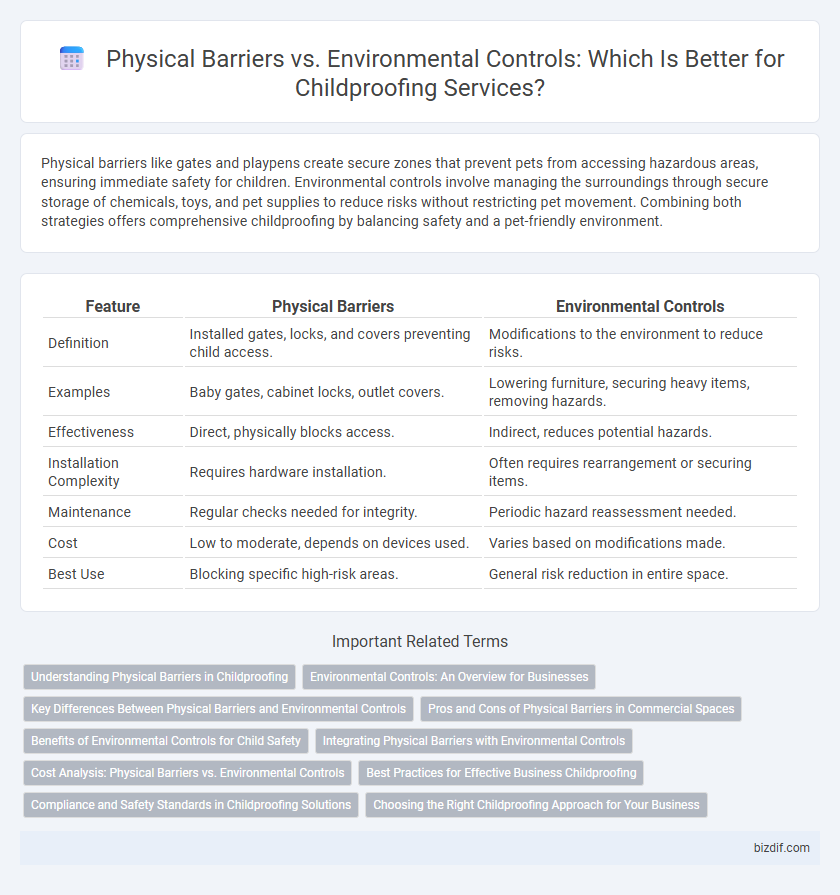Physical barriers like gates and playpens create secure zones that prevent pets from accessing hazardous areas, ensuring immediate safety for children. Environmental controls involve managing the surroundings through secure storage of chemicals, toys, and pet supplies to reduce risks without restricting pet movement. Combining both strategies offers comprehensive childproofing by balancing safety and a pet-friendly environment.
Table of Comparison
| Feature | Physical Barriers | Environmental Controls |
|---|---|---|
| Definition | Installed gates, locks, and covers preventing child access. | Modifications to the environment to reduce risks. |
| Examples | Baby gates, cabinet locks, outlet covers. | Lowering furniture, securing heavy items, removing hazards. |
| Effectiveness | Direct, physically blocks access. | Indirect, reduces potential hazards. |
| Installation Complexity | Requires hardware installation. | Often requires rearrangement or securing items. |
| Maintenance | Regular checks needed for integrity. | Periodic hazard reassessment needed. |
| Cost | Low to moderate, depends on devices used. | Varies based on modifications made. |
| Best Use | Blocking specific high-risk areas. | General risk reduction in entire space. |
Understanding Physical Barriers in Childproofing
Physical barriers in childproofing involve installing gates, locks, and covers that prevent children from accessing hazardous areas or objects, enhancing safety by creating controlled zones. These barriers provide a tangible obstruction that is easy to implement and customize based on specific household risks, such as staircases, electrical outlets, or cabinets containing harmful substances. Understanding the effectiveness and placement of physical barriers is crucial for maximizing protection and reducing accident risks in homes with young children.
Environmental Controls: An Overview for Businesses
Environmental controls in childproofing focus on modifying the surroundings to minimize hazards, including installing outlet covers, securing loose wires, and using non-toxic materials that ensure child safety. Businesses benefit from these controls by creating safer environments that comply with safety regulations, reducing liability risks and enhancing customer trust. Effective environmental controls complement physical barriers by addressing potential dangers that physical barriers alone cannot mitigate, ensuring comprehensive child safety.
Key Differences Between Physical Barriers and Environmental Controls
Physical barriers, such as safety gates and cabinet locks, physically prevent access to hazardous areas or objects, providing immediate and tangible protection for children. Environmental controls involve modifying the surroundings, like adjusting lighting, organizing furniture layout, or securing loose cords, to reduce risks indirectly. Key differences lie in their approach: physical barriers create direct, hard limits, while environmental controls enhance overall safety by altering the environment's potential hazards.
Pros and Cons of Physical Barriers in Commercial Spaces
Physical barriers in commercial spaces offer a reliable way to prevent child access to hazardous areas, enhancing safety by creating clear, visible boundaries. They are durable and require minimal maintenance, but can sometimes obstruct emergency exits or interfere with the aesthetic design of the facility. While effective at containment, physical barriers may limit flexibility in space usage and require regular inspections to ensure structural integrity and compliance with safety codes.
Benefits of Environmental Controls for Child Safety
Environmental controls significantly enhance child safety by reducing access to hazards through strategic design and layout modifications, such as cord management and furniture anchoring. These controls create a safer environment without relying solely on physical barriers, which can limit child mobility and independence. Implementing environmental controls fosters a secure, accessible space that encourages exploration while minimizing risks.
Integrating Physical Barriers with Environmental Controls
Integrating physical barriers with environmental controls enhances childproofing by combining tangible safety measures, such as gates and locks, with adjustments to the environment like outlet covers and secured furniture placement. This dual approach significantly reduces hazards by preventing access to dangerous areas while minimizing risks through controlled environmental factors. Utilizing both strategies together creates a comprehensive safety network that effectively protects children from common household dangers.
Cost Analysis: Physical Barriers vs. Environmental Controls
Physical barriers like gates, locks, and safety latches typically involve one-time installation costs ranging from $20 to $150 per unit, providing durable protection in childproofing. Environmental controls, such as smart home sensors and automated shut-offs, often require higher initial investments between $200 and $600, plus potential subscription fees for monitoring services. While physical barriers offer cost-effective, tangible prevention methods, environmental controls add remote monitoring capabilities and adaptability but may entail higher long-term expenses.
Best Practices for Effective Business Childproofing
Implementing physical barriers such as safety gates and cabinet locks effectively restricts access to hazardous areas, reducing injury risks in childproofed spaces. Environmental controls, including proper lighting and outlet covers, complement barriers by minimizing potential dangers within the environment. Combining both strategies ensures comprehensive safety, aligning with best practices for professional business childproofing services.
Compliance and Safety Standards in Childproofing Solutions
Physical barriers like safety gates and window guards must comply with ASTM and CPSC safety standards to prevent falls and restrict access to hazardous areas effectively. Environmental controls, such as furniture anchors and outlet covers, adhere to UL certification and meet child safety regulations to minimize injury risks from tipping or electrical hazards. Ensuring these compliance standards in childproofing solutions enhances overall safety and reduces liability in both residential and commercial settings.
Choosing the Right Childproofing Approach for Your Business
Physical barriers like safety gates and cabinet locks provide direct prevention against hazards by restricting child access, ideal for high-risk areas in childcare centers or pediatric clinics. Environmental controls, including secured furniture placement and safe room layouts, reduce risks by altering surroundings to create a safer atmosphere, preferred in spaces requiring open movement or adult supervision. Selecting the right childproofing approach depends on business-specific factors such as space usage, caregiver accessibility, and local safety regulations to effectively minimize accidents.
Physical Barriers vs Environmental Controls Infographic

 bizdif.com
bizdif.com